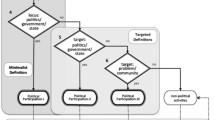Abstract
This article discusses the spatial particles/prepositions up, down, in and out in four languages: English, Norwegian, Swedish and Danish. These spatial items can select directly for a DP complement in English and Norwegian, thus looking like regular prepositions; they require a complement preceded by a light preposition in Danish and Swedish, thus looking more like particles. We will argue that in none of the four languages under discussion can the relevant spatial items directly select a DP ground element, but require either an overt or a null P head that converts a DP object to a path location.
Similar content being viewed by others
References
Beck, S., and K. Johnson. 2002. Double objects again. Linguistic Inquiry 35:97–123.
den Dikken, M. 1995. Particles: on the syntax of verb-particle, triadic and causative constructions. New York: Oxford University Press.
den Dikken, M. 2009. On the functional structure of locative and directional pps. In The cartography of prepositional phrases, eds. G. Cinque and L. Rizzi. Oxford/New York: Oxford University Press.
Folli, R. 2003. Deriving telicity in English and Italian. Ph. D thesis, Oxford University.
Gawron, J.-M. 2003. Generalized paths. Paper presented at SALT XV, available at http://www-rohan.sdsu.edu/~gawron/salt_paper.pdf.
Hale, K., and S. J. Keyser. 2002. Prolegomenon to a theory of argument structure. Number 39 in linguistic inquiry monograph. Cambridge: MA: MIT Press.
Higginbotham, J. 2001. Accomplishments. ms. Oxford University.
Hulthén, L. 1944. Jämförande Nunordisk Syntax. Göteborgs Högskolas Årsskrift. Göteborg: Elanders Boktryckeri Acktiebolag.
Kayne, R.S. 2004. Here and there. In Syntax, lexis and lexicon-grammar: papers in honor of Maurice Gross, eds. C. Leclère, E. Laporte, M. Piot and M. Silberztein, 2453–273. Amsterdam: John Benjamins.
Kracht, M. 2002. On the semantics of locatives. Linguistics and Philosophy 25:157–232.
Krifka, M. 1998. The origins of telicity. In Events and grammar, ed. S. Rothstein, 197–235. Dordrecht: Kluwer.
Lakusta, L., and B. Landau. 2005. Starting at the end: the importance of goals in spatial language. Cognition 96:1–33.
Lakusta, L., and B. Landau. 2012. Language and memory for motion events: origins of the asymmetry between goal and source paths. Cognitive Science, 36(3):517–544.
Lakusta, L., L. Wagner, K., O’Hearn, and B. Landau. 2007. Conceptual foundations of spatial language: evidence for a goal bias in infants. Language Learning and Development 3(3):179–197.
Lundquist, B., and G. Ramchand. 2012. Contact, animacy and affectedness in germanic. In Proceedings of comparative germanic syntax CGSW 23 and 24, eds. P. A. Rhona Alcorn and C. Heycock. John Benjamins.
Pantcheva, M. 2011. Decomposing path. Ph. D. thesis, Universitetet i Tromsø, Tromsø.
Papafragou, A. 2010. Source-goal asymmetries in motion representation: implications for language production and comprehension. Cognitive Science 34:1064–1092.
Parsons, T. 1990. Events in the semantics of English: a study in subatomic semantics. Cambridge, MA: MIT Press.
Pustejovsky, J. 1991. The syntax of event structure. Cognition 41:47–81.
Radkevich, N. 2010. On location: the structure of case and adpositions. Ph. D. thesis, University of Connecticut.
Ramchand, G. 2008. Verb meaning and the Lexicon. Cambridge University Press.
Regier, T., and M. Zheng. 2007. Attention to endpoints: a cross-linguistic constraint on spatial meaning. Cognitive Science 31:705–719.
Son, M., and P. Svenonius. 2008.Microparameters of cross-linguistic variation: directed motion and resultatives. In Proceedings of the 27th West Coast Conference on Formal Linguisticsm, eds N. Abner and J. Bishop, 388–396. Somerville, MA: Cascadilla Press.
Svenonius, P. 1996. The verb-particle alternation in the Scandinavian languages. ms. University of Tromsø.
Svenonius, P. 2006. The emergence of axial parts. Nordlyd Tromsø Working Papers in Linguistics 33(1):49–77.
Svenonius, P. 2008. The position of adjectives and other phrasal modifiers in the decomposition of dp. In Adjectives and adverbs: syntax, semantics and discourse, eds. L. McNally and C. Kennedy, 16–42. Oxford University Press.
Svenonius, P. 2010. Spatial P in English. In The cartography of syntactic structures, mapping spatial PPs, eds. G. Cinque and L. Rizzi Svenonius, vol 6. Oxford University Press.
Talmy, L. 1978. Figure and ground in complex sentences. In Universals of human language, ed. J. H. Greenberg, vol 4, 625–649. Stanford: Stanford University Press.
Terzi, A. 2010. Locative prepositions and place. In The cartography of syntactic structures, mapping spatial PPs, eds. G. Cinque and L. Rizzi, vol 6, 196–223. Oxford University Press.
van Riemsdijk, H. 1978. A case study in syntactic markedness: the binding nature of prepositional phrases (2nd edn). Dordrecht: Foris.
van Riemsdijk, H, and R Huybregts. 2002. Location and locality. In Progress in grammar: articles at the 20th anniversary of the comparison of grammatical models group in Tilburg, eds. M. van Oostendorp and E. Anagnostopoulou, 1–23. Amsterdam: Meertens Instituut.
von Stechow, A. 1996. The different readings of wieder ‘again’: a structural account. Journal of Semantics 13:87–138.
Wunderlich, D. 1991. How do prepositional phrases fit into compositional syntax and semantics? Linguistics 29:591–621.
Zwarts, J. 2005. Prepositional aspect and the algebra of paths. Linguistics and Philosophy. to appear.
Zwarts, J., and Y. Winter. 2000. Vector space semantics: a model-theoretic analysis of locative prepositions. Journal of Logic Language, and Information 9:169–211.
Author information
Authors and Affiliations
Corresponding author
Rights and permissions
About this article
Cite this article
Lundquist, B., Ramchand, G. Objects as locations in English and Mainland Scandinavian. J Comp German Linguistics 16, 159–187 (2013). https://doi.org/10.1007/s10828-013-9058-y
Received:
Accepted:
Published:
Issue Date:
DOI: https://doi.org/10.1007/s10828-013-9058-y




